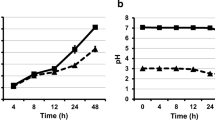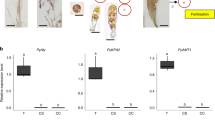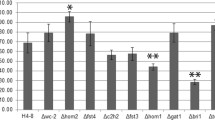Abstract
Morphogenesis of pycnidium of Truncatella angustata BPF5 has been studied under in vitro culture on l-arabinoze medium. A single stalked, lemon shaped and papillate initial cell seems to take part in the formation of pycnidium. The apical papilla of initial cell elongates so as to give the initial a central position flanked by hyphae. This single initial by successive divisions becomes an oval pycnidial primordium (trichomeristogenous). Further enlargement of pycnidium seems to take place due to mechanical force exerted by successive conidial formation. At maturity, the pycnidium is melanized. Some primordia abort leaving behind ghost pycnidia in the central disc. The minimal supplemented media like l-arabinoze medium reduce vegetative growth but induce early pycnidial formation thus requiring less teasing operations during microscopy. This in turn avoids damage of fragile young structures and facilitates study of developmental stages. This is the first report of early stages of pycnidial development under in vitro condition in any of the Coelomycetous fungus.



Similar content being viewed by others
References
Watanbe K, Doi Y, Kobayashi T (1997) Pycnidial development of Phyllosticta harai and Spheropsis sp. Mycoscience 38:259–265. https://doi.org/10.1007/bf02464083
Watanabe K, Kobayashi T, Doi Y (1998) Conidiomata of Truncatella sp. on different media. Nippon Kingakukai Kaiho 39:21–25
Murugan M, Arumugam P, Arunkumar K (2016) Developmental morphology of conidiomata in Phyllosticta Caryotae. J Bacteriol Mycol 3:1038
Watanabe K (1998) Conidiomatal development of Pestalatiopsis guepinii and P. neglecta on leaves of Gardenia jasminoides. Mycoscience 39:71–75. https://doi.org/10.1007/BF02461581
Schnegg H (1915) Zur Entwicklungsgeschichte und Biologie der Pykniden, sowie der Schlingenmycelien und Hyphenknauel. Centralbl Bakt II 43:326
Kempton FE (1919) Origin and development of the Pycnidium. Bot Gaz 68(4):233–261
DiCosmo F, Cole GT (2011) Morphogenesis of conidiomata in Chaetomella acutiseta (Coelomycetes). Can Bot 58:1129–1137. https://doi.org/10.1139/b80-139
Taylor JE, Crous PW, Swart L (2001) Foliicolous and caulicolous fungi associated with Proteaceae cultivated in California. Mycotaxon 78:75–103
Hu LP, Ma CH, Yang GM, Tan WJ (1996) Studies on the causal agent of apple mouldy core and core rot. J Fruit Sci 13:157–161
Espinoza JG, Briceño EX, Keith L, Latorre BA (2008) Canker and twig dieback of blue berry caused by Pestalotiopsis spp. and a Truncatella spp. in Chile. Plant Dis 92:1407–1414. https://doi.org/10.1094/PDIS-92-10-1407
Arzanlou M, Torbati M, Jafary H (2012) Fruit rot of olive (Olea europaea) caused by Truncatella angustata. Plant Pathol Quar 2:117–123. https://doi.org/10.5943/ppq/2/2/4
Eken C, Spanbayev A, Tulegenova Z, Abiev S (2009) First report of Truncatella angustata causing leaf spot on Rosa canina in Kazakhstan. Aust Plant Dis Notes 4:44–45. https://doi.org/10.1071/DN09018
Aliddi A, Kowsari M, Javan-Nikkhah M, Karami S (2018) First report of leaf spot caused by Truncatella angustata on Persian Oak (Quercus brantii) in Iran. Plant Dis 102:1173
Wenneker M, Pham KTK, Boekhoudtm LC, de Boer FA, van Leeuwen PJ, Hollinger T, Thomma BPHJ (2017) First report of Truncatella angustata causing postharvest rot on ‘Topaz’ apples in the Netherlands. Plant Dis 101:508
Jagielski T, Zak I, Tyrak J, Bryk A (2015) First probable case of subcutaneous infection due to Truncatella angustata: a new fungal pathogen of humans. J Clin Microbiol 53:1961–1964. https://doi.org/10.1128/JCM.00400-15
Guba EF (1961) Monograph of Monochaetia and Pestalotia. Harvard University Press, Cambridge
Singh P, Hamid B, Lone MA, Ranjan K, Khan A, Chaurse VK, Sahay S (2012) Evaluation of Pectinase activity from the psychrophilic fungal strain Truncatella angustata-BPF5 for use in wine industry. J Endocytobiosis Cell Res 22:57–61
Sahay S (1999) Phenylalanine transport in Aspergillus nidulans: demeonstration of role of Phenylalanine binding protein. Ind J Exp Biol 37:152–156
Sutton BC (1980) The Coelomycetes. Commonwealth Mycological Institute, Kew, p 696
Nag Raj TR (1993) Coelomycetesous anamorphs with appendage-bearing conidia. Mycologue Publications, Waterloo
Esteve-Zarzoso B, Belloch C, Uruburu F, Querol A (1999) Identification of yeasts by RFLP analysis of the 5.8 s rRNA gene and the two ribosomal internal transcribed spacers. Int J Syst Bacteriol 49:329–337. https://doi.org/10.1099/00207713-49-1-329
Tamura K, Peterson D, Peterson N, Stecher G, Ne M, Kumar S (2011) MEGA5: molecular evolutionary genetics analysis using maximum likelihood, evolutionary distance, and maximum parsimony methods. Mol Biol Evol 28:2731–2739. https://doi.org/10.1093/molbev/msr121
Kim YK, Xiao CL, Rogers JD (2005) Influence of culture media and environmental factors on mycelia growth and pycnidial production of Sphaeropsis pyriputrescens. Mycologia 97(1):25–32. https://doi.org/10.3852/mycologia.97.1.25
Moran GP, Coleman DC, Sullivan DJ (2011) Comparative genomics and the evolution of pathogenicity in human pathogenic fungi. Eukaryot Cell 10(1):34–42. https://doi.org/10.1128/EC.00242-10
Fedorova ND, Khaldi N, Joardar VS, Maiti R, Amedeo P, Anderson MJ et al (2008) Genomic islands in the pathogenic filamentous fungus Aspergillus fumigatus. PLoS Genet 4(4):e1000046. https://doi.org/10.1371/journal.pgen.1000046
Sahay S, Hamid B, Singh P, Ranjan K, Chauhan D, Rana RS, Chaurse VK (2013) Evaluation of pectinolytic activities for oenological uses from psychrotrophic yeasts. Lett Appl Microbiol 57(2):115–121. https://doi.org/10.1111/lam.12081
Sahay S, Lone MA, Jain P, Singh P, Chouhan D, Shezad F (2013) Cold-active moulds from Jammu and Kashmir, India as potential source of coldactive enzymes. Am J Curr Microbiol 1(1):1–13
Acknowledgements
Financial assistance in the form of major project grant from Madhya Pradesh Council of Science and Technology, Bhopal is gratefully acknowledged.
Author information
Authors and Affiliations
Corresponding author
Ethics declarations
Conflict of interest
The author declares that he has no conflict of interest.
Additional information
Significance statement The accumulating evidences suggest that Truncatella angustata is pathogenic to economically important plants and possibly human being and source of cold-active enzymes, hence study of the biology of this taxon including pycnidium development is important.
Rights and permissions
About this article
Cite this article
Sahay, S. Novel Trichomeristogenous Development of Pycnidium in Truncatella angustata BPF5 (Coelomycete). Proc. Natl. Acad. Sci., India, Sect. B Biol. Sci. 89, 979–985 (2019). https://doi.org/10.1007/s40011-018-1016-7
Received:
Revised:
Accepted:
Published:
Issue Date:
DOI: https://doi.org/10.1007/s40011-018-1016-7




